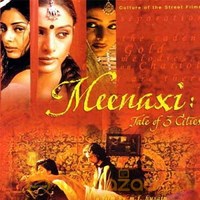
Meenaxi - A Tale of 3 Cities Movie Reviews
| Starring | Tabu, Kunal Kapoor, Raghuvir Yadav |
|---|---|
| Music | A. R. Rahaman |
| Director | MF Husain |
| Year | 2004 |
| Rating |
Meenaxi - A Tale of 3 Cities Review
by MyMazaa.comPainter M.F. Husain's second directorial venture "Meenaxi: Tale of 3 Cities" dwells on the ageless debate over the intricate relationship between the creator and his creation, the artiste and his art, and the painter and his brush.
Flitting across three time zones, the film takes the viewer through its basic debate on art, life and illusion, transporting Husain's vision into the realm of poetry.
Somewhere in the middle of this seamless tale Tabu, playing an elusive creature of fugitive desires in Jaisalmer, steals into Kunal's haveli on tiptoe with the express intention of making her feelings manifest.
But Kunal (played by a refreshingly natural, non-iron-pumping Kunnal Kapoor) is shy and apprehensive.
"You here at this time of the night?" he looks uneasily over his shoulder. And Meenaxi's face falls.
The scene where the woman, at the risk of her own reputation, steals into the arms of passion, seems like M.F. Husain's tribute to the immortal "Devdas".
As far as Meenaxi is concerned it's the end of love. But for the author Nawab, played by Raghuvir Yadav, it's the cue for a new beginning.
He can now take his heroine into another dimension, another continent, another chance for Tabu to showcase her enchanting enigma.
Between the brush and the brush-stroke of "Meenaxi: A Tale Of 3 Cities", there lies a universe of feelings and emotions, many inexpressible, almost as elusive as Tabu's eyes which wander beyond the flaming frames of the screen to gaze at the very essence of love and existence.
The first of the three Tabus who colonise M.F. Husain's tale of three cities is a perfume seller in Hyderabad.
As Santosh Sivan dodges autorickshaws and commuters in the cluttered Hyderabad to zero in on Meenaxi, the camera becomes the conscience of Nawab, the author searching for the perfect heroine for his next novel.
Perfection being the grandest illusion of art and life, Nawab finds Meenaxi, the wily, pushy, slightly crude but deliciously seductive ittar seller.
It's in the way that Husain looks for imperfection in art that "Meenaxi" shines way beyond his earlier somewhat scrambled stab at direction in "Gaja Gamini".
Tabu may not be as graceful and nimble-footed as Madhuri Dixit. But she carries the weight of the film's basic debate on art, life and illusion with a fertile facility.
The film's three segments are not mutually exclusive in the way of, say Raj Kapoor's "Mera Naam Joker". Characters overlap, collide and coalesce to the point where borders between feeling and manifestation, thought and expression seem to become joined in the dance of life.
Deliberately, M.F. Husain makes his characters talk in an unusually loud voice.
In one sequence he personally appears at a Irani restaurant and winces the minute the first Tabu, the ittar-seller, opens her mouth to nag the writer Nawab.
Her raging passion to alchemise her ordinary life into art through Nawab's pen is also every artiste's craving for immortality through his art.
It's that craving which comes across in Tabu's remarkable presence. To call it a performance would be belittling what Husain and she have set out to achieve in the frames.
As Tabu travels from one time zone to another she transports us to another world where 'maya' (illusion) seduces and caresses reality. True, her Czech accent in the last overture is strained.
But then, this is a film of heightened realism where the characters are entirely emblematic. Their value is not in what they speak but what they hold back for a time that never comes.
The soundtrack and visual texture of "Meenaxi" elevate the film to a work of endless enchantment. The now-you-see-her-now-you-don't quality in the three-tiered protagonist's personality makes her a creation of caprice like no other in Hindi cinema.
The overt and aggressive manner in which the songs and dances come on indicate a celebration of life in swirling blues, opulent oranges and ravishing reds.
Only a painter could infuse such a steep sense of aesthetics into the narrative canvas. The frames are opulent and yet not crowded.
Every song and dance from "Rang hai" to "Titli daboch li maine" (the latter, a fascinating and beguiling study of brothel eroticism) is heart-stopping in its mixture of melody and emotions that yield a lingering and lush lyricism.
Admittedly, parts of the film are enormously self-indulgent. Though all the three cities, Hyderabad, Jaisalmer and Prague - living throbbing characters in Husain's fey scheme of life and art - are beautifully framed in the narration, some portions of the visuals appear touristy.
On the other hand, the sheer energy and passion of the 88-year old creator's mise en scene makes you sit and savour every stroke of look in the narration.
When the third Tabu, Maria in Prague, shyly tells Kunal that she walks with and not rides her bicycle because she needs company, you want time to freeze so you can savour the mystery and poetry of her confession.
Sweet melodious, tender and seductive, "Meenaxi" is at once a celebration of abstractionism and a mirror into the heart of a woman who's as haunted and haunting as Meena Kumari in Bimal Roy's Sahib Bibi Aur Ghulam, as enigmatic as Rosy in Vijay Anand's Guide and as voluptuous and famished as Smita Patil in Shyam Benegal's Bhumika.
Indeed, Tabu, Santosh Sivan and A.R. Rahman are the three heroes of the film.
"Meenaxi" is a film you'd want to clutch close to your heart for these three, and also for M.F. Husain's dextrous transposition of the painter's skill on celluloid whereby every stroke of the brush engenders an atom of poetry.










